Serving 265 students in grades 9-12, Wheeler County High School ranks in the bottom 50% of all schools in Georgia for overall test scores (math proficiency is bottom 50%, and reading proficiency is bottom 50%).
The percentage of students achieving proficiency in math is 10-14% (which is lower than the Georgia state average of 37%). The percentage of students achieving proficiency in reading/language arts is 30-34% (which is lower than the Georgia state average of 40%).
The student:teacher ratio of 13:1 is lower than the Georgia state level of 14:1.
Minority enrollment is 44% of the student body (majority Black), which is lower than the Georgia state average of 65% (majority Black).
Quick Stats (2025)
- Grades: 9-12
- Enrollment: 265 students
- Student:Teacher Ratio: 13:1
- Minority Enrollment: 44%
- Graduation Rate: 90-94% (Top 30% in GA)
- Overall Testing Rank: Bottom 50%
- Math Proficiency: 10-14% (Btm 50%)
- Reading Proficiency: 30-34% (Btm 50%)
- Science Proficiency: 30-34% (Btm 50%)
- Source: National Center for Education Statistics (NCES), GA Dept. of Education
Top Rankings
Wheeler County High School ranks among the top 20% of public schools in Georgia for:
Category
Attribute
Community Size
School Overview
Wheeler County High School's student population of 265 students has declined by 10% over five school years.
The teacher population of 20 teachers has stayed relatively flat over five school years.
Grades Offered
Grades 9-12
Total Students
265 students
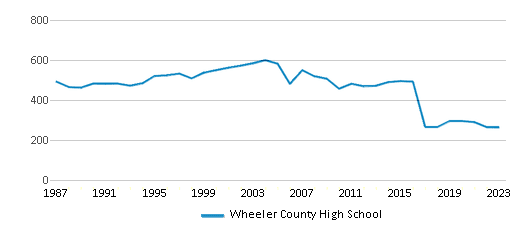
Gender %
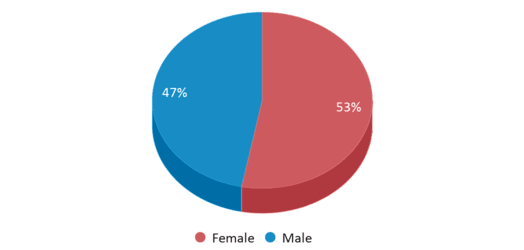
Total Classroom Teachers
20 teachers
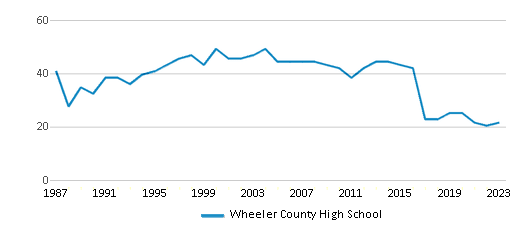
Students by Grade
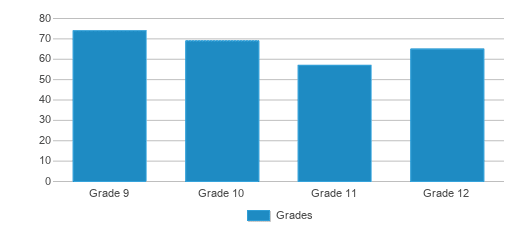
School Calendar
School Rankings
Wheeler County High School ranks within the bottom 50% of all 2,204 schools in Georgia (based off of combined math and reading proficiency testing data).
The diversity score of Wheeler County High School is 0.56, which is less than the diversity score at state average of 0.71. The school's diversity has stayed relatively flat over five school years.
Overall Testing Rank
#1597 out of 2204 schools
(Bottom 50%)
(Bottom 50%)
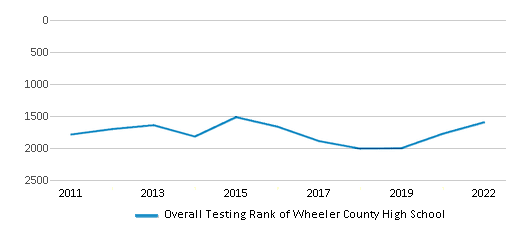
Math Test Scores (% Proficient)
10-14%
37%
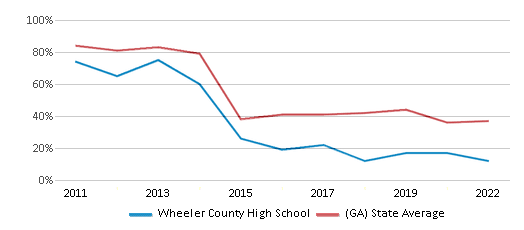
Reading/Language Arts Test Scores (% Proficient)
30-34%
40%

Science Test Scores (% Proficient)
30-34%
40%
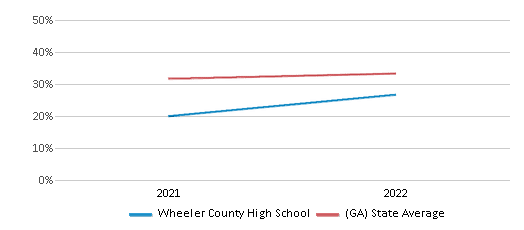
Student : Teacher Ratio
13:1
14:1
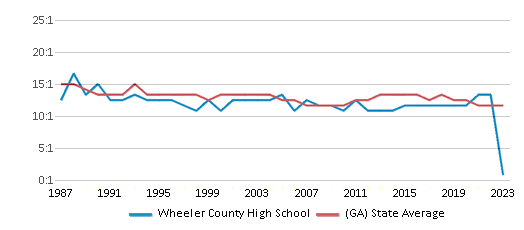
American Indian
n/a
n/a
Asian
n/a
5%
Hispanic
7%
19%
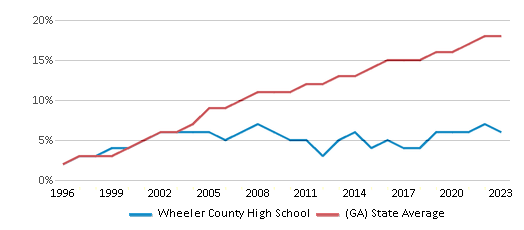
Black
35%
36%
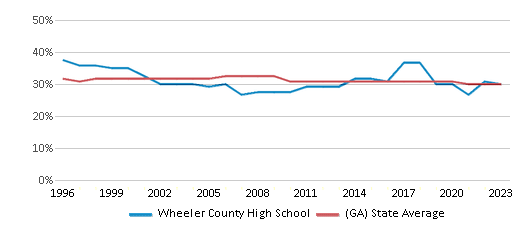
White
56%
35%
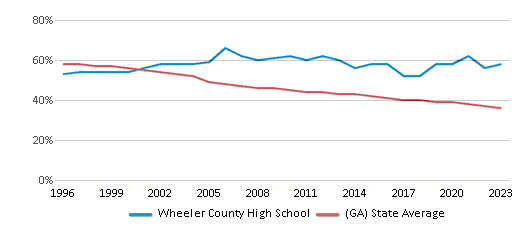
Hawaiian
n/a
n/a
Two or more races
2%
5%
All Ethnic Groups
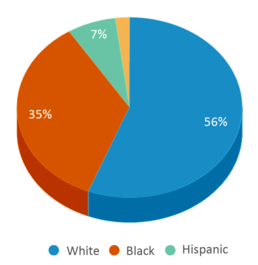
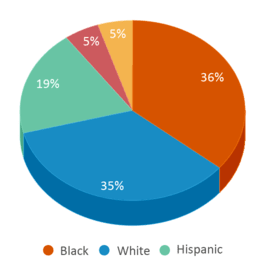
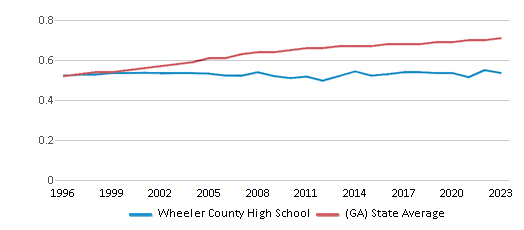
Graduation Rate
90-94%
84%
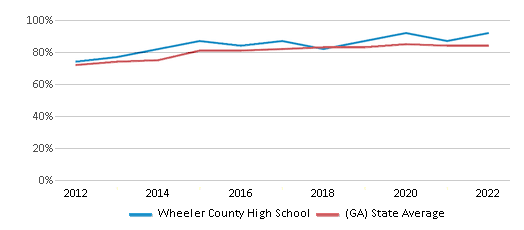
Participates in the National School Lunch Program (NSLP)
Yes
Eligible for Free Lunch
66%
59%
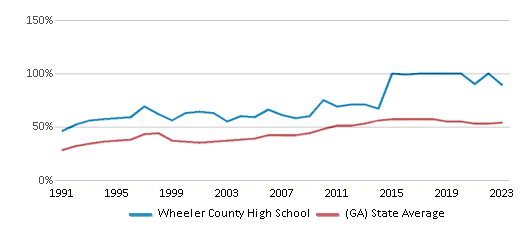
Eligible for Reduced Lunch (13-14)
7%
6%
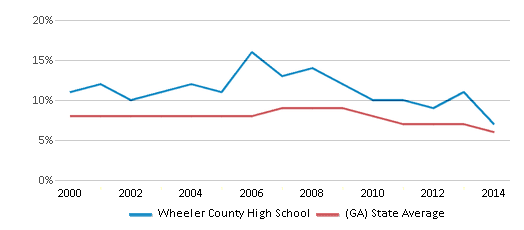
School Statewide Testing
School District Name
Source: National Center for Education Statistics (NCES), GA Dept. of Education
Profile last updated: 02/09/2025
Frequently Asked Questions
What is Wheeler County High School's ranking?
Wheeler County High School is ranked #1597 out of 2,204 schools, which ranks it among the bottom 50% of public schools in Georgia.
What percent of students have achieved state testing proficiency in math and reading?
10-14% of students have achieved math proficiency (compared to the 37% GA state average), while 30-34% of students have achieved reading proficiency (compared to the 40% GA state average).
What is the graduation rate of Wheeler County High School?
The graduation rate of Wheeler County High School is 90-94%, which is higher than the Georgia state average of 84%.
How many students attend Wheeler County High School?
265 students attend Wheeler County High School.
What is the racial composition of the student body?
56% of Wheeler County High School students are White, 35% of students are Black, 7% of students are Hispanic, and 2% of students are Two or more races.
What is the student:teacher ratio of Wheeler County High School?
Wheeler County High School has a student ration of 13:1, which is lower than the Georgia state average of 14:1.
What grades does Wheeler County High School offer ?
Wheeler County High School offers enrollment in grades 9-12
What school district is Wheeler County High School part of?
Wheeler County High School is part of Wheeler County School District.
School Reviews
5 12/22/2021
This school system offers its students everything they can with the amount of funding they actually receive. The low test scores, which leads to the low overall school test ranking, aren't low because of the teachers/staff. It is low because of the portion of students that struggle with carelessness and lack of motivation. As a WCHS alumni, i have witnessed several students with no motivation, no additional help (outside of school), and no guidance. Yes, the teachers and staff could help by pushing a little harder, but a student's success is mainly achieved by the student's willingness and their parent's willingness to chip in where they can. Overall, this school system goes above and beyond with an interest in getting each and every student to the field walking at graduation. The principal, the counselor, and the entirety of the staff, along with the W.C.B.O.E., strive to prepare their students for life outside of those high school walls. All in all....Everyone A Leader c/o 2021 ~Mikky
Review Wheeler County High School. Reviews should be a few sentences in length. Please include any comments on:
- Quality of academic programs, teachers, and facilities
- Availability of music, art, sports and other extracurricular activities
Recent Articles

What Is A Charter School?
Explore the world of charter schools in this comprehensive guide. Learn about their history, how they operate, and the pros and cons of this educational innovation. Discover key facts about charter schools, including admission policies, demographics, and funding, as well as what to look for when considering a charter school for your child.

10 Reasons Why High School Sports Benefit Students
Discover the 10 compelling reasons why high school sports are beneficial for students. This comprehensive article explores how athletics enhance academic performance, foster personal growth, and develop crucial life skills. From improved fitness and time management to leadership development and community representation, learn why participating in high school sports can be a game-changer for students' overall success and well-being.

February 05, 2025
Understanding the U.S. Department of Education: Structure, Impact, and EvolutionWe explore how the Department of Education shapes American education, from its cabinet-level leadership to its impact on millions of students, written for general audiences seeking clarity on this vital institution.









